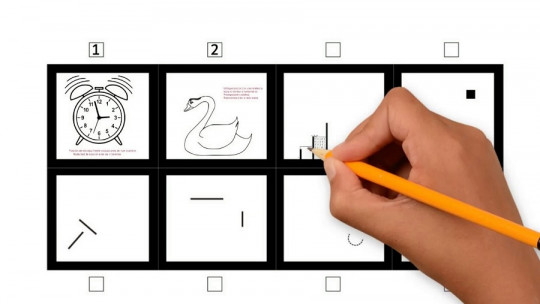This article explores the use and interpretation of the 7 Element Test in psychological evaluation, a little-known but potentially revealing tool of unconscious aspects of personality.
The theoretical foundations of the test, its practical application and the results obtained from its use in a diverse sample of participants are examined. The importance of understanding the subjective interpretation of the drawings is highlighted and the implications of the findings for psychological evaluation are discussed..
Debate on projective tests
In the field of psychological evaluation, there is a constant debate about the scientific value of projective tests, generating much controversy. For those who delve into the literature on these techniques for the first time, they encounter a disconcerting paradox: the precise definition of projective tests is not as clear as was believed.
Unlike structured personality tests, considered more objective, projective tests present ambiguous stimuli, ink blots, or the request to interpret or give open-ended responses, such as creating drawings; which allows great flexibility in possible responses. Some experts define them as tools that allow a wide range of responses, sometimes infinite, making a definition too broad..
In general, projective methods or tests seek to provoke responses to ambiguous stimuli or without defined structure, which are then interpreted as a reflection of the unconscious structure and dynamics of the personality. Approximately 1959, these have been classified according to the type of response. that induce in the evaluated:
This classification highlights the diversity of approaches in projective testing, each aimed at exploring different aspects of the unconscious personality through spontaneous or creative responses.
The interpretation of projective tests is qualitative and subjective, based on clinical experience and deep theoretical knowledge, with a focus on the construct of projection..
Therefore, although projective techniques can be considered psychological tests in terms of their construction and administration, they differ in the way they are scored, given that there are various non-standardized methods for their evaluation.
Given the above, the behavior of a little-known but revealing projective test will be explained below. It reveals a large amount of information regarding the examinee. The test is known as “the 7 Elements Test” and applies what is requested by the examiner. Test can be classified as expressive, but when properly applied, it is also sought to be placed among construction tests.
The 7 Elements Test
The 7 Elements Test is a little-known test that consists of asking the person to draw six specific elements and one additional element. This test has the theoretical assumption that human beings project unconscious aspects about their personal life, family patterns and personal limits in their drawings.. In this context, in this article it is of great interest to project the different results that have been obtained when applying the 7 Elements Test to different people of different ages between seven years and eighty-five years.
The Seven Elements Test is a projective technique based on graphic drawing and the use of symbolic language, which facilitates the unconscious expression of certain deep traits of human subjectivity. Through this technique, it is possible to evaluate the self-perception and social development of the applicants, considering aspects such as family relationships and personal barriers that influence their perception of themselves and their interaction with others.
Each element constitutes a projective self-portrait at a different level, most of them based on archetypes, which are the form given to some experiences and memories of our first ancestors, “this implies that we do not develop in isolation from the rest of us.” society, but the cultural context influences us in the most intimate, transmitting to us schemes of thought and experimentation of reality that are inherited”, in other words, Archetypes are emotional and behavioral patterns that shape the way we process sensations, images, and perceptions as a meaningful whole..
Somehow, archetypes accumulate in the depths of the collective unconscious to form a mold that gives meaning to what happens to each person. The interpretation of the drawings in the 7 Elements Test can be done from three analytical perspectives:
This test has little recorded history, which is why this article seeks to create visibility of the effectiveness of the test, emphasizing that there are tests with a history for decades such as HTP (House-Tree-Person), Family Test , Person in the rain, among others that provide symbolism to the drawings.
As in these other projective techniques, the 7 Elements Test is based on a free graph, where the applicant is asked to spontaneously draw a house, a tree, a river, a sun, a railing, a snake and an additional element. that you want to add. The graphics are made on white sheets and with a graphite pencil.
The contribution of this reagent in the psychological evaluation lies in the fact that, through the drawings, it is possible to identify how a person experiences their self in relation to their limitations, their family and their social environment.
Experimentation with the 7-item test
A research is carried out with a mixed methodology, that is, both qualitative and quantitative methods were combined, in which a descriptive scope is obtained, which implies that it was possible to understand and describe in detail a particular phenomenon or situation with transectal temporality. That is, the phenomenon was examined at a specific moment in time, without following its evolution.
When applying the 7 Elements Test to the participants, it was observed that the majority of the participants clearly understood the interpretation of the projective test after its application. This ability to understand can suggest an adequate receptivity on the part of the participants towards the technique and the implications of their answers, which strengthens the validity of the results obtained and the accessibility that the test provides by being able to generate awareness through self-assessment..
Finally, the test generates a final question to obtain quantitative data, indicating the following question: From 1 to 10, with 1 being “nothing” and 10 being “everything”, that is, 10 the test is an x-ray of your life, What is the result of this test after interpretation? It is observed that the majority agree with the result presented in the 7 Elements Test, being analyzed with each person by the professional in charge with prior knowledge of the test.
Conclusions
The majority of participants clearly understood the interpretation of the projective test after its application, suggesting adequate receptivity toward the technique and the implications of their responses. This finding strengthens the validity of the results obtained and the usefulness of the test as a psychological evaluation tool.
Some participants expressed skepticism or asked questions after the test was administered, especially in group contexts. However, It was observed that this skepticism dissipated after receiving detailed and personalized explanations about the interpretation of the test items.. This highlights the importance of providing feedback and clarity to participants to mitigate any doubts or concerns.
It is recognized that all projective tests carry a high subjective load in the personal construction of reality, manifested through drawing. Likewise, it is highlighted that a projective test cannot be standardized to reflect human personality traits in an absolute and general way. However, this study has allowed an approach to the possible differences between the participants and has provided valuable information on the application and interpretation of the Seven Elements Test.









